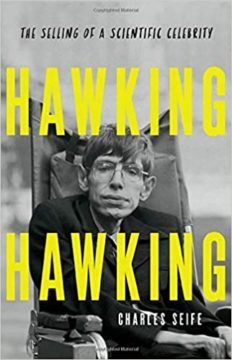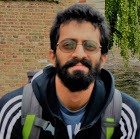by Madhusudhan Raman
 All of human life is quite literally coded into two long, complementary strands of genetic material that fold themselves into a double helix. When cells divide, copies of this genetic code must be made – a process that is known as replication. The double helix unwinds, and a “replication fork” makes its way down the helix in much the same way that a slider separates the teeth of a zipper. Once separated, enzymes get to work on replicating them. Except, only one of the strands is replicated continuously. The second strand is replicated piecewise first, and these pieces – called Okazaki fragments – are then fused together.
All of human life is quite literally coded into two long, complementary strands of genetic material that fold themselves into a double helix. When cells divide, copies of this genetic code must be made – a process that is known as replication. The double helix unwinds, and a “replication fork” makes its way down the helix in much the same way that a slider separates the teeth of a zipper. Once separated, enzymes get to work on replicating them. Except, only one of the strands is replicated continuously. The second strand is replicated piecewise first, and these pieces – called Okazaki fragments – are then fused together.
Biography, too, is an act of replication. The biographer takes a life and sets out to write its ink-and-paper twin. And while most biographers transcribe life continuously, following the natural flow of time from birth to death, Charles Seife courageously swims against the current. For in Hawking Hawking: The Selling of a Scientific Celebrity, we are treated to an Okazaki-esque biography: one that is discontinuously told, pieced together and related in reverse.
In his twenties, Stephen W. Hawking was diagnosed with amyotrophic lateral sclerosis, a neurodegenerative disorder that caused him to progressively lose control of nerve cells that allow for movement. His disability, which soon necessitated the use of a motorised wheelchair and a computerised speech device, defined him in the eyes of the public, much to his disappointment. Hawking the Pop Culture Icon was in his element in the limelight, though, enjoying a celebrity status that afforded him cameos in Star Trek and The Simpsons, in addition to a number of other documentaries.
To the scientifically inclined lay-person, Hawking was heir to the mantle of Galileo, Newton and Einstein, a comparison he worked hard to invite but modestly rejected in interviews. When I was a young boy, the name ‘Hawking’ immediately conjured up the image of a wheelchair-bound genius who, with great courage and fortitude, overcame the limitations of his emaciated body, allowing his mind to roam freely across space and time, busy uncovering the mysteries of the universe. Hawking was greeted by packed auditoriums and lecture halls where ever he was scheduled to speak, where young and old alike, on the edge of their seats, would hang on every word he said. His steady repertoire of bon mots, and above all his mischievous smile, would routinely make their way into the pages of newspapers, often alongside grandiose pronouncements on subjects he probably knew very little about, like stem cell research or artificial intelligence. It didn’t matter. To them, Hawking was science incarnate.
Within the small community of theoretical physicists, Hawking was known for his contributions to gravitation and cosmology. Beginning with his work on the singularity theorems, which proved that under reasonable assumptions, singularities – points in spacetime where matter was infinitely compressed – were bound to form, Hawking would go on to produce a stream of incisive studies of black holes, those mysterious astrophysical objects that form once a star dies. He is also fondly remembered for co-authoring (with George F. R. Ellis) a magisterial technical monograph titled The Large-Scale Structure of Spacetime, now considered a classic in the field.
Black holes were named for an extraordinary property they have that distinguishes them from other astrophysical objects: their gravitational pull is so strong that not even light can escape them. The result Hawking is most widely known for is his demonstration that black holes… well, aren’t so black after all. In investigating the behaviour of quantum theories near a black hole, Hawking would demonstrate that black holes actually did radiate, that they had a temperature.
The significance of this result is difficult to understate. In all sciences, new paradigms (in the sense of Kuhn) arise out of the resolution of contradictions inherent to and characteristic of science at its present state of development. For example, in the early years of the 20th century, the contradiction between Galilean relativity (which formed the basis of Newtonian mechanics) and Maxwell’s theory of electric and magnetic forces necessitated the development of the special theory of relativity, which in turn altered our understanding of space and time itself. It is often the case that these contradictions, manifested as conceptual or experimental points of conflict where competing frameworks butt heads, point the way towards new paradigms in science. The contradiction Hawking uncovered, between quantum mechanics and general relativity, is known as the black hole information paradox, and a little under fifty years since it was first described, it remains an active area of research.
Except, the public knew nothing of this work. They were drawn in by his mind-over-matter story, his humor in the face of adversity. He was more Metaphor than Man. How does one tell his story?
By running it backwards in time, answers Seife. And he proves equal to the task at hand; if the reader should feel any apprehension about reading a biography that moves back and forth through time, they will find in Seife a capable and gentle steward. While steering clear of hagiography, he systematically chips away at the layers of celebrity and fame that had encrusted Hawking, obscuring the person underneath. He begins with Hawking as the world came to know him, and works his way towards Hawking as he was, both professionally and personally.
Seife does not shy from noting instances when Hawking’s professional behaviour was far less than ideal: the story of his repeated attempts to kick a graduate student out of the PhD program at Cambridge because his line of research didn’t align with Hawking’s own thinking at the time; his habit of taking credit for the work of his students and even collaborators; his unsubstantiated accusations of plagiarism against junior academics. These anecdotes paint a very different picture of Hawking, one that may be difficult for the fawning public to accept. He becomes, through Seife’s retelling, a man who was deeply invested in the mythology that he had systematically built up around himself.
Hawking became a household name after the publication of A Brief History of Time, which catapulted him from respected domain expert to international scientific celebrity. It was written in part to help defray Hawking’s growing medical expenses, and in part to quench his yearning for wider recognition. Seife writes vividly of the laborious transmutation of Hawking’s original 100-page manuscript into the runaway bestseller it would eventually become. This process involved the work of many students, editors, and science writers, none of whom received much credit for their work. This, we learn, is true of his subsequent works as well. Much of his later popular work was pieced together from the transcripts of his old talks, or ghostwritten. Where his earlier work was recycled and repackaged, it offered (in the words of Helen Mialet in Hawking Incorporated: Stephen Hawking and the Anthropology of the Knowing Subject) unique insight: “the drafting process that would normally take us closer to the ‘origin’ of the process of creation – that is, to ‘the author’ – lead instead to a hall of mirrors.” And where the work that carried his name was authored by ghostwriters, another, more sinister transmutation was underway: Hawking the Celebrity was building Hawking the Brand.
Hawking’s imprimatur, which at times seemed carelessly given, instantly conferred upon even the strangest projects – like Russian billionaire Yuri Milner’s search for radio signals from aliens – a legitimacy they would scarcely have enjoyed otherwise. His close association with a number of wealthy individuals (Werner Erhard, Jeffry Epstein, George Mitchell, Peter Diamandis, and even Richard Branson) anticipated an increasingly common trend: at least in string theory, privately funded collaborations and conferences have grown, and they have had an effect on research priorities and the sociology of the field. Brand Hawking was not always cringeworthy, however: he went to bat for the National Health Service when it faced funding cuts, supported the academic boycott of Israel in solidarity with Palestine, decried the US invasion of Iraq, and routinely used his celebrity to raise awareness and money for various charities.
Seife seamlessly weaves together biography and science writing, contextualising Hawking’s science against a lucid discussion of the research into gravitation and cosmology that took place during Hawking’s lifetime. His writing is often peppered with anecdotes related by Hawking’s close friends, collaborators, and students, which go a long way towards giving the reader insights into the man behind the metaphor.
Hawking’s life was made up of many fragments: scientist, author, celebrity, husband, father. Seife’s thoughtful biography shows us each of these facets of Hawking’s personality, and collects these fragments together with commendable skill, never giving in to the temptation to be overly fawning or uncharitable. What emerges – a far cry from Hawking the Phenomenon – is a more whole picture of the life of Stephen Hawking, one that is inspiring, thought-provoking, and singular.
***
 Madhusudhan Raman is a theoretical high-energy physicist, currently working as a postdoctoral fellow at the Tata Institute of Fundamental Research in Mumbai, India.
Madhusudhan Raman is a theoretical high-energy physicist, currently working as a postdoctoral fellow at the Tata Institute of Fundamental Research in Mumbai, India.
